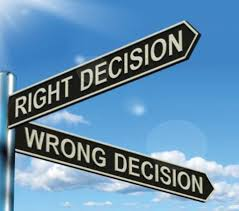
What if you discovered that up to half of your time and money is being wasted? That you are throwing away half of your hard-earned money and working twice as much as you need to? Well, brace yourself. Studies find that people on average do just that and the culprit – poor decision making, especially on decisions with long-term consequences.
Have you ever made a major decision? Rhetorical question, right? If you’ve ever been in a relationship, selected a college, bought a house, changed jobs, decided where to invest a significant amount of time or money, or took a substantial risk, you made a major decision. Life is full of major decisions and your current circumstances are the result.
Our decisions define what we do, when we do it, where we do it, and with whom we do it – both personally and professionally. Yet many people don’t give thought to how they make decisions. They don’t realize they make decisions based on emotion rather than logic. They don’t realize they ask for advice from like-minded or biased people. They don’t understand that making the easiest decision often isn’t the best decision. Or that postponing a decision is a decision itself. Or that they choose to let the urgent displace the important. That bad decisions work out only because extra effort and resource are expended. Or that fundamental decisions are pushed aside for inconsequential ones.
Perhaps poor decision making is most obvious when we think back to our teenage years. Not only did we lack knowledge and experience, but our brains weren’t developed. Particularly for us young males, as neuroscience research confirms, the thrill-seeking part of our brain (ventral striatum) had not yet made connections to our thinking brain (pre-frontal cortex) leaving us to drive too fast, stay out too late, and ignore the better advice given to us by our parents.
But poor decision-making habits aren’t only attributable to the young and inexperienced. People of all ages make impulse buying decisions. Adult singles fall into relationships they later regret. Employees don’t leverage their resources. Managers make bad hires. Committees select the wrong vendors. Executives authorize bad investments. Entrepreneurs get into bad partnerships. Homeowners hire incompetent subcontractors. Ouch, right? We’ve all been there. Police, courts, jails, lawyers, counselors, doctors, hospitals, clinics, repair shops, drug companies, non-profit organizations, and countless other entities exist in large part due to people’s bad decisions. The “bad decision industry” is alive and well.
If you’ve not done so, give some thought to how you make decisions. What typically leads to good outcomes? Bad outcomes? What lessons have you learned from past decisions and how have you incorporated them into your current decision making? Compare your list of lessons learned to the decision-making best practices listed below:
- Defer fun, gratification, and the allure of the easiest or quickest solution. Don’t fall for short-term fixes (or pleasures) that create undesirable long-term consequences.
- Ask “why” a few times, e.g. “Why is this a problem?” and “Why does this happen?” until you move beyond symptoms and arrive at the root cause(s) most deserving of a decision.
- Conduct research, analyze available (secondary) data, or collect and analyze new (primary) data as needed to facilitate more objective and fact-based decisions.
- Assess contributing factors such as incentives, systems, other resources, other people, and yourself for the possibility that the real decision to be made isn’t on that which you are most focused.
- Solicit the opinions of others, particularly those with diverse opinions, to offset biases such as confirmation bias, status-quo bias, sunk-cost bias, availability bias, scarcity bias, group think, and big egos.
- Have at least 2-3 alternatives to evaluate rather than merely deciding on one alternative, e.g. compare a car, ride sharing, and public transportation rather just deciding to buy or not buy a car.
- Consider the consequences of doing nothing. Make decisions rather than avoid them when time is against you. Many issues aren’t like fine wine. They don’t get better with age.
- Consider the timing and what else should be done before this decision. When there are multiple decisions and contributing factors, address them in the optimal order.
- Establish your decision criteria before evaluating your options. A decision based on the lowest cost will be very different than a decision based on risk or the impact it has on your reputation.
- Consider the impact of your decision on others. If a solution helps you, but harms others, reconsider. Favor the alternative that helps others. Their response will be much more positive.
- Have nothing to hide. Don’t choose an alternative you wouldn’t want printed on the front page of a newspaper with your name on it or distributed through social media. Decisions become known.
- Validate your decision if possible before implementing it, e.g. try before buying, build a prototype. Be open to changing direction if assumptions change or the results aren’t what you expected.
Do you have any big decisions ahead? Apply these decision-making best practices and enjoy the extra money, enjoy the extra time, and perhaps avoid regrets as a result – both personally and professionally.
Download PDF version
Article by Mike Hawkins, award-winning author of Activating Your Ambition: A Guide to Coaching the Best Out of Yourself and Others (www.ActivatingYourAmbition.com), author of the SCOPE of Leadership six-book series on coaching leaders to lead as coaches (www.ScopeOfLeadership.com), and president of Alpine Link Corp (www.AlpineLink.com), a boutique consulting firm specializing in leadership development and sales performance improvement. For other articles on reaching your peak potential, visit: www.alpinelink.com/blog
